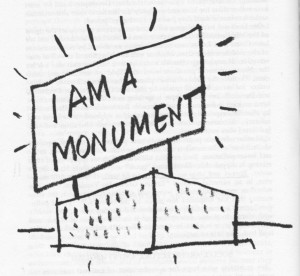 The book launch of Civic Art, a history of the first hundred years of the U.S. Commission of Fine Arts, was the occasion for the Charles Atherton Memorial Lecture at the National Building Museum, delivered this year by Thomas Luebke, the current secretary of the commission. In the course of his talk, Luebke made an interesting observation: commemorative memorials in Washington, D.C. have become increasingly influenced by other media, specifically photography. When the Lincoln Memorial was completed in 1922, Daniel Chester French’s statue of the president was the sculptor’s interpretation of his subject (French did have access to a life mask of Lincoln, as well as plaster casts of his hands), and in due course the seated figure became a national icon. When the Marine Corps Memorial was unveiled in 1954, it consisted of a giant statue based on the AP correspondent Joe Rosenthal’s photograph of Marines raising the flag at Iwo Jima. Instead of creating an original work, the “sculptor,” one Felix de Weldon, simply appropriated an already famous image. The photo, not the memorial, was the real icon. More recent commemorative works, such as the Martin Luther King Jr. Memorial, have been similarly based on photographs. Likewise the current version of the proposed memorial to Dwight D. Eisenhower. Why does this matter? Memorials that simply mimic another medium lose much of their power; they are more like billboards than sacred markers. Robert Venturi once proposed that a civic building should be designed as a simple box with a blinking sign on top saying I AM A MONUMENT. One is never quite sure how seriously to take Venturi’s offbeat pronouncements, but the current crop of photographic-inspired memorials suggests just how thin the joke really is.
The book launch of Civic Art, a history of the first hundred years of the U.S. Commission of Fine Arts, was the occasion for the Charles Atherton Memorial Lecture at the National Building Museum, delivered this year by Thomas Luebke, the current secretary of the commission. In the course of his talk, Luebke made an interesting observation: commemorative memorials in Washington, D.C. have become increasingly influenced by other media, specifically photography. When the Lincoln Memorial was completed in 1922, Daniel Chester French’s statue of the president was the sculptor’s interpretation of his subject (French did have access to a life mask of Lincoln, as well as plaster casts of his hands), and in due course the seated figure became a national icon. When the Marine Corps Memorial was unveiled in 1954, it consisted of a giant statue based on the AP correspondent Joe Rosenthal’s photograph of Marines raising the flag at Iwo Jima. Instead of creating an original work, the “sculptor,” one Felix de Weldon, simply appropriated an already famous image. The photo, not the memorial, was the real icon. More recent commemorative works, such as the Martin Luther King Jr. Memorial, have been similarly based on photographs. Likewise the current version of the proposed memorial to Dwight D. Eisenhower. Why does this matter? Memorials that simply mimic another medium lose much of their power; they are more like billboards than sacred markers. Robert Venturi once proposed that a civic building should be designed as a simple box with a blinking sign on top saying I AM A MONUMENT. One is never quite sure how seriously to take Venturi’s offbeat pronouncements, but the current crop of photographic-inspired memorials suggests just how thin the joke really is.
On Culture and Architecture
